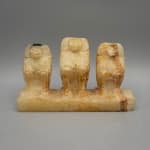New Kingdom Monkey Cosmetic Jars, 16th Century BCE to 11th Century BCE
Alabaster
7.9 x 13.8 x 4.9 cm
3 1/8 x 5 3/8 x 1 7/8 in
3 1/8 x 5 3/8 x 1 7/8 in
EL.0040
Further images
-
(View a larger image of thumbnail 1
)

-
(View a larger image of thumbnail 2
)

-
(View a larger image of thumbnail 3
)

-
(View a larger image of thumbnail 4
)

-
(View a larger image of thumbnail 5
)

-
(View a larger image of thumbnail 6
)

-
(View a larger image of thumbnail 7
)

-
(View a larger image of thumbnail 8
)

-
(View a larger image of thumbnail 9
)

Monkeys often appear as decoration on objects related to cosmetics from the ancient Egyptian period. In art, they are shown interacting with humans, and sometimes on leashes, showing that they...
Monkeys often appear as decoration on objects related to cosmetics from the ancient Egyptian period. In art, they are shown interacting with humans, and sometimes on leashes, showing that they were kept as pets by the upper classes. The baboon also had a place within Egyptian mythology; Thoth, who was the god of the moon, scribes, writing, science, judgement, knowledge, and the afterlife, was sometimes represented as a baboon, usually squatting with his hands on his knees. The use of the baboon as a symbol for this god suggests that the ancient Egyptians viewed baboons as intelligent creatures. They were also linked to the cult of the sun-god Ra, because they bark in the morning, appearing to greet the sun. Hapi, one of the four sons of Horus, whose heads were used to decorate canopic jars in which the organs of the deceased were stored, was also represented as a baboon.
These three monkeys, sitting crouched on a base, would have been used to hold cosmetics. They are all of slightly varying sizes, with the largest in the middle, and they each have a hole in the top of their head which reaches deep inside their bodies. Both men and women wore makeup in ancient Egypt. Eyes were outlined with kohl, as well as a green paint called Udju which was made of malachite. Ground red ochre was mixed with water to make a paste which could be used on the lips or cheeks. Cosmetic palettes have been discovered from predynastic Egypt which are thought to have been used for grinding cosmetic pigments. Later, jars such as this one were produced which were able to hold substances like kohl. It would have been applied with a stick dipped into the hole. The monkeys have large ears, and peaceful expressions. Incised lines decorate their bodies, showing the texture of their fur. The hole inside the monkey on the left contains traces of a black pigment.
These three monkeys, sitting crouched on a base, would have been used to hold cosmetics. They are all of slightly varying sizes, with the largest in the middle, and they each have a hole in the top of their head which reaches deep inside their bodies. Both men and women wore makeup in ancient Egypt. Eyes were outlined with kohl, as well as a green paint called Udju which was made of malachite. Ground red ochre was mixed with water to make a paste which could be used on the lips or cheeks. Cosmetic palettes have been discovered from predynastic Egypt which are thought to have been used for grinding cosmetic pigments. Later, jars such as this one were produced which were able to hold substances like kohl. It would have been applied with a stick dipped into the hole. The monkeys have large ears, and peaceful expressions. Incised lines decorate their bodies, showing the texture of their fur. The hole inside the monkey on the left contains traces of a black pigment.








